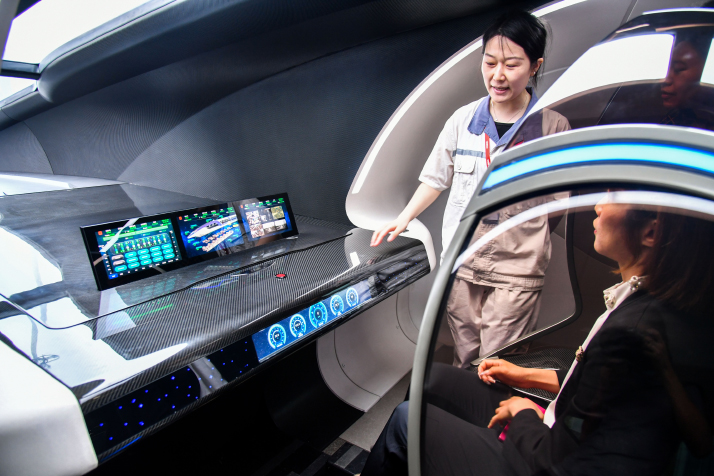| China |
| In achieving greater sci-tech self-reliance, China also pursues more international cooperation | |
|
|
 An employee of Siempelkamp (Qingdao) Machinery and Equipment Co. Ltd. talks with his German counterpart via video link from Qingdao, Shandong Province, on June 28 (WEI YAO)
Two years ago on July 20, a maglev train with a designed speed of 600 km per hour—the fastest land vehicle available globally—rolled off the production line and made its public debut in the coastal city of Qingdao, Shandong Province. The achievement raises the bar for China's railway manufacturing industry, according to China Railway Rolling Stock Corp. (CRRC), the country's largest railway vehicle manufacturer. The Qingdao-based CRRC Qingdao Sifang Co. Ltd., a subsidiary of the CRRC and the developer of the maglev train, has also been playing a part in the design and manufacturing of the high-speed electric passenger trains to be used in the Jakarta-Bandung High-Speed Railway in Indonesia, the first project of its kind in Southeast Asia. With a total length of 142 km, the line built with Chinese technology connects Jakarta, the Indonesian capital, and Bandung, a famous tourist city, and is scheduled to start operating this August. Li Chuanying, head of the International Sci-Tech Cooperation Department of CRRC Qingdao Sifang, told Beijing Review that as China is achieving greater sci-tech self-reliance and pursuing more collaboration with other countries to promote innovation, his company is putting great effort into cooperating with countries participating in the Belt and Road Initiative (BRI). The China-proposed initiative aims to boost connectivity along and beyond the ancient Silk Road routes. In June, Li's company hosted a seminar in Thailand to share China's experience in rail transit technology innovation with local railway operators.  A visitor experiences the high-speed maglev train with a designed speed of 600 km per hour at the CRRC Qingdao Sifang Co. Ltd. in Qingdao, Shandong Province, on June 29 (WEI YAO)
Explorations Qingdao has taken many measures in the past decades to deepen international cooperation, not only to boost its own economic development, but also to bring more opportunities to partners. The China-Shanghai Cooperation Organization (SCO) Local Economic and Trade Cooperation Demonstration Area, for example, is playing a big role in linking enterprises at different tiers of industrial and supply chains and gathering global innovation resources. Founded in 2001, the SCO currently consists of China, India, Iran, Kazakhstan, Kyrgyzstan, Pakistan, Russia, Tajikistan and Uzbekistan. The demonstration area, established in 2019, is a platform to expand exchange between SCO countries and countries participating in the BRI. Local authorities have made a number of reforms in the demonstration area to simplify administrative procedures and create an environment conducive for domestic and foreign professionals and entrepreneurs to start their businesses. A comprehensive economic and trade service platform, launched in 2022, has registered nearly 5,000 enterprises from 27 industries including electronics, biomedicine and mechanical equipment manufacturing. "It took me only eight hours to complete company registration procedures on the platform," Jiang Gongbao, founder of Shandong Longai Science and Technology Development Co. Ltd., said. His company provides services for technology transfer and recruitment of professionals from home and abroad. The Sino-German Ecopark was launched in July 2013. It is the only one of its kind supported by a cooperation agreement between the Chinese and German governments. According to Peter Tichauer, media director of the Sino-German Ecopark and editor in chief of German-language magazine China Insight, the Ecopark is not merely an industrial park, but has also become a community for companies. One of his responsibilities is to introduce local investment advantages and Chinese economic development trends to entrepreneurs, to attract more foreign companies to invest in China and collaborate with their Chinese counterparts. On June 29, the annual China-Japan-Republic of Korea (ROK) Conference of Engineering and Technology began in the Ecopark. The event hosted subforums concerning advanced materials, smart life, genetic science and biomedicine, with participating experts conducting academic exchanges and sharing their ideas on how to further cooperate in sci-tech innovation, personnel training and other fields. More can be done The sound environment, advanced laboratories and well-equipped researchers have all laid a good foundation for China to become a global sci-tech innovation hub in the future, 73-year-old Ukrainian geo-physicist and radio-physicist Leonid Feoktistovich Chernogor told Beijing Review. Chernogor currently works at the College of Electronics and Information at Qingdao University. During his 50-year scientific career, he has focused on the fundamental applications of space science. In 2016, he began working in China and has since witnessed in person the country's rising strength in research and development (R&D). According to the Ministry of Science and Technology, China's R&D expenditure tripled from 2012 to 2022, with the number reaching 3.09 trillion yuan ($426 billion) last year. Its ranking in the Global Innovation Index also rose from the 34th spot in 2012 to 11th place in 2022, according to the World Intellectual Property Organization (WIPO). Zhang Guangjun, Vice Minister of Science and Technology, said in February that China has established scientific and technological cooperation partnerships with more than 160 countries and regions, and signed 116 inter-governmental agreements concerning such collaboration. For instance, China has signed space cooperation agreements or memoranda of understanding with France, Germany, Italy, Russia, Pakistan and several other countries. China's Tiangong space station is the first of its kind open to all UN member states. Regarding the CRRC's cooperation, Li told Beijing Review that the company has conducted extensive exchanges with other countries in composite materials and other fields in recent years. It has established some overseas R&D centers, has worked with institutions in the U.S., Germany, the UK, Italy, Thailand and other countries, and is establishing a dedicated laboratory for future international collaboration. Kim Nam Hyung, who hails from the ROK and works in R&D for Qingdao Haier Biotech Co. Ltd., told Beijing Review, "As a foreign scientist working in China, I should play a more important role as a bridge to enhance the technical exchange between China and the ROK in the field of high-end biotechnology, introduce more talents and enterprises to China, and jointly promote the rapid development of the life-science industry in Qingdao and even the whole country." According to Kim, like other countries, China still has a lot of room to commercialize its scientific and technological achievements. In terms of those internationally recognized sci-tech challenges, Chernogor, the Ukrainian scientist, suggested China's assessment mechanism should be eased. "Science is unpredictable and some research results may, in the end, prove to be invalid. We must be more tolerant toward such results," he said, adding that an important goal of sci-tech development is to cultivate international top research teams across borders and fields. (Print Edition Title: The Power of Joining Hands) Copyedited by G.P. Wilson Comments to mamm@cicgamericas.com |
|
||||||||||||||||||||||||||||
|
